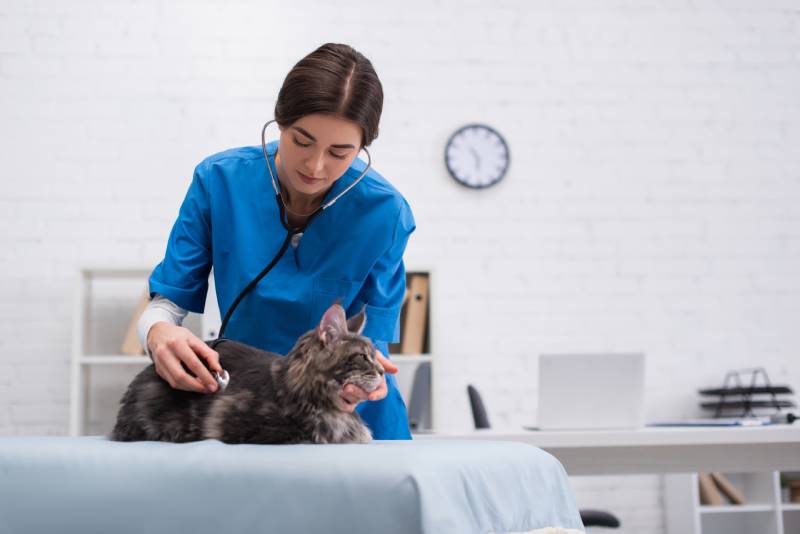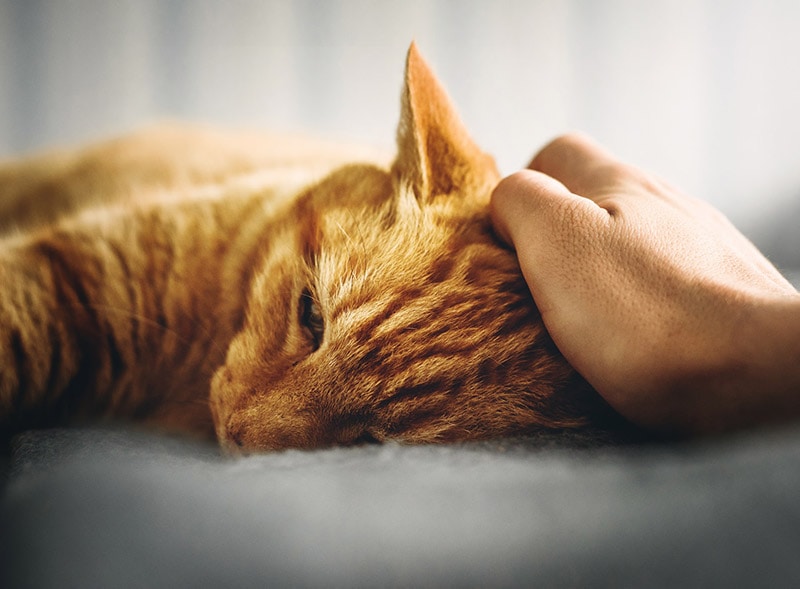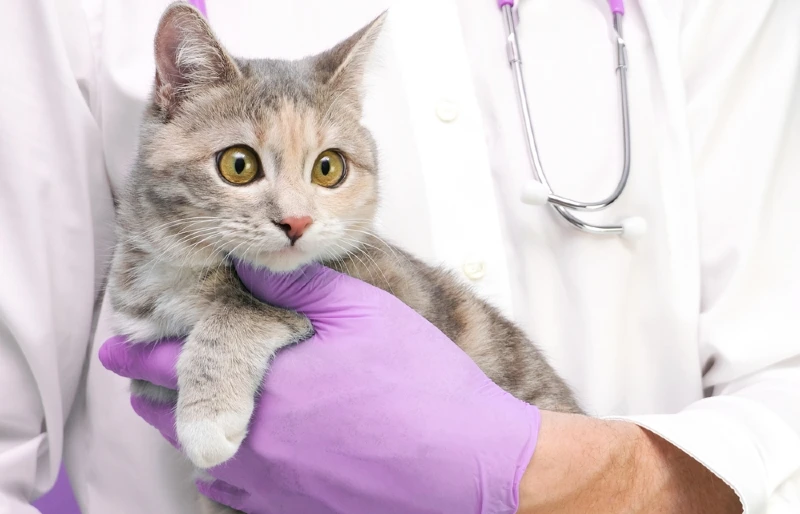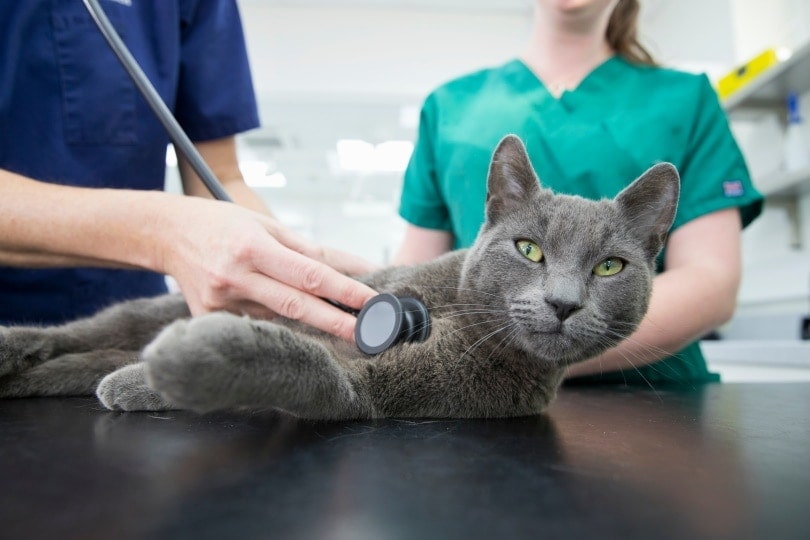Osteomyelitis in Cats: Our Vet Explains Signs, Prevention & Treatment
Updated on

There are many well-known diseases and conditions of bones that the average person knows about. Those include fractures, malformations, bone density loss, and cancers. One serious disease that is very often less known is osteomyelitis, a long scientific word that simply means inflammation of the bone. Inflammation in other tissues is common, so why is osteomyelitis less well-known? The answer has to do with how infrequently it occurs (except in the mouth) and what causes it, so let’s go over everything.

What Is Osteomyelitis?
Osteomyelitis, or bone inflammation, almost always occurs secondary to infection but can occur without one. The inflammation causes the body to try to heal the bone by removing damaged, dead bone tissue and placing down new tissue. The problem is that this process hurts, and if the causative agent for the inflammation isn’t treated, the body will continue to break down more and more bone. This weakens the overall bone, which can cause it to fracture with normal usage and prevent the use of stabilizing implants to try and get it to heal.

What Are the Signs of Osteomyelitis in Cats?
You would think that inflammation and infection of the bone would have obvious signs, but that isn’t always true. Swelling in the area of the affected bone that may be painful to the touch or cause limping can be present. This swelling can persist and worsen, but sometimes it goes away within a couple of weeks, causing owners to think the problem has been resolved.
In these cases, signs may come and go for some time without being obvious. Draining tracts may form, fractures may occur from everyday activities that shouldn’t break a bone, or wounds may fail to heal in more significant or identifiable cases.
Affected cats may appear lethargic, eat or drink less, hide, vocalize, limp, or have a fever when checked.
What Causes Osteomyelitis in Cats?

- Bacteria: This is the most common cause of osteomyelitis in cats and usually enters the bone through wounds, traveling from the skin into the area of the bone, though it can also enter through surgery, on implants or sutures, and other foreign bodies.
- Fungal: Though far less common than bacteria, fungal infections can form in bones in some cases for cats. Fungal infections are generally region specific and may be linked to immunosuppression in the cat.
- Sterile: While technically possible, sterile osteomyelitis is inflammation without an infectious agent and is incredibly rare in cats.
Cats receive wounds or undergo surgeries without developing osteomyelitis all the time, so there are some additional factors that increase the risk of osteomyelitis forming.
- Unstable bone fractures
- Soft tissue injury
- Bone necrosis (dead bone)
- Bone sequestration (a piece of live bone surrounded entirely by dead bone or tissue)
- Foreign material present (sutures, implants, penetrating objects)
- Immunosuppression

How Is Osteomyelitis in Cats Diagnosed?
X-rays of the affected bone can show lesions consistent with osteomyelitis, but in the first couple weeks of progression, X-rays are often normal. Rechecking X-rays in 2-week intervals can help identify changes.
To check for the presence of bacterial or fungal infections, a needle aspirate is used to collect a sample that then undergoes culture and sensitivity testing to identify what is present and, in the case of bacteria, what antibiotics it will respond to for treatment. This information allows the doctor to know what type of osteomyelitis they’re dealing with.
Since osteomyelitis can look similar to cancer on X-rays, biopsies are sometimes taken of the bone to definitively diagnose one or the other.

How Is Osteomyelitis in Cats Treated?
Treatment for osteomyelitis depends on the cause.
For osteomyelitis present due to a foreign body, the foreign material—even if they’re surgical implants—needs to be removed.
Open wounds need to be closed and healed to prevent the worsening of osteomyelitis.
For bacterial osteomyelitis, appropriate antibiotics need to be given, preferably by IV first, then orally at home for four to six weeks.
Fungal osteomyelitis infections respond to antifungal medication, but the treatment length may be several months or even more than a year.
Cats can have chronic recurrences of their osteomyelitis, and treatment may need to be restarted throughout their life for some cats.
Some cats may need surgical procedures to remove dead bone and clean up the edges of remaining bone, and new bone can be placed in the area to help kick start new healthy bone growth if needed.
How Do I Care for a Cat With Osteomyelitis?
Since clinical signs often lead to visual changes on X-rays, careful monitoring for signs is an important part of treatment and identification at home. This is especially in important cats that tend towards chronic recurrences.
Communicating with your veterinarian about pain control, appetite, water intake, and energy levels can help them choose supportive care that best helps a specific cat.
Maintaining the recheck schedule assigned by the veterinarian is very important since these cases can take so long to treat and heal. It can be hard work giving cats medication for this long and taking them into a clinic for several rechecks, so be sure to talk to your veterinary team if you’re having difficulties so they can troubleshoot with you and make sure doses of medication aren’t being missed, nor are rechecks.
How Can Osteomyelitis Be Prevented in Cats?
Timely treatment of any bone fractures is critical in preventing osteomyelitis.
Good dental care is also important since this is the most common site of osteomyelitis in cats. The care taken to train a cat to adjust to tooth brushing from a young age can really help with this.


Frequently Asked Questions
What is the survival rate of osteomyelitis in cats?
Most cats will survive in most cases though amputation of limbs rather than pursuing osteomyelitis treatment can occur. In some cases, euthanasia may be elected, especially if the cat is painful and not responding well to treatment.
What bacteria causes osteomyelitis in cats?
Many different types of bacteria can cause osteomyelitis, but Staphylococcus is the most common type, which is a bacteria normally found on a cat’s skin as part of their normal bacterial flora.
What is the most common site of osteomyelitis in cats?
Often overlooked, dental infections are the most common cause of osteomyelitis, but since we usually refer to these as tooth root abscesses, this is why many people don’t recognize the term osteomyelitis. A cat’s teeth communicate directly with bone, and dental infections very often cause osteomyelitis in the area. Removing diseased teeth and treating the infection is the treatment in this case.

Conclusion
Cats with osteomyelitis may have obvious, large, painful swellings, or potentially no signs at all. Cats are notorious for hiding pain, so cases that don’t form large swellings or draining tracts can be missed for long periods of time. Tooth root infections may not be found if the cat continues to eat normally and isn’t examined by a veterinarian. Most cases respond to treatment which is usually at least daily medication but may include surgery, but some bones may need to be removed entirely via amputation in some cases. If you notice signs of osteomyelitis in your cat that go away, this does not rule out the disease and that cat should be checked by a veterinarian to be sure.
Featured Image Credit: LightField Studios, Shutterstock









